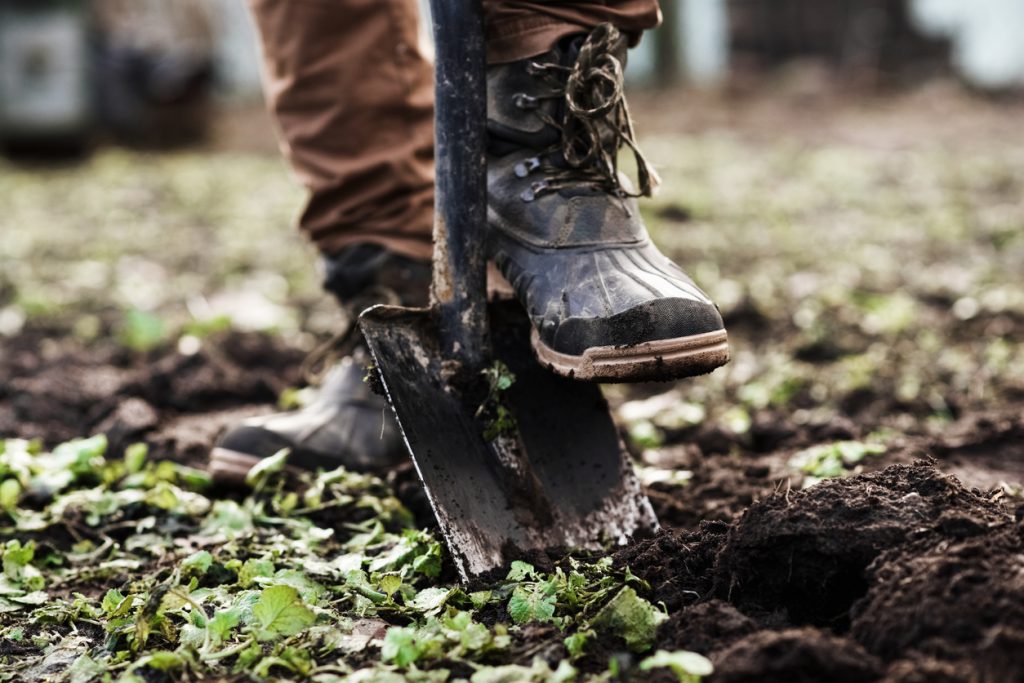THINK BEFORE YOU PLACE DOWN FABRIC UNDER MULCH
Landscape fabric is a popular tool many homeowners use to try to keep weeds out of their mulch bed and/or flower garden. Of course, it is easy to understand why this product is so popular. Who wouldn’t want to simply roll out a piece of fabric or plastic sheet to prevent weeds from growing in their yard? Unfortunately, many homeowners do not use landscape fabric for its intended purpose, which can end up creating unexpected problems. If you are planning on adding mulch to your landscaping, it is imperative that you do not use an artificial weed barrier such as plastic or landscape fabric. Here is a look at five reasons why using landscape fabric under mulch is a bad idea.
1.) MULCH FABRIC DOESN’T STOP WEED GROWTH
The most common misconception about landscape fabric is that it will prevent weeds from growing in mulch beds and flower gardens; unfortunately, this is not the case. While the landscape fabric will smother weeds in the soil below the fabric, and kill them within a few weeks of the fabric being laid down, this likely won’t be a long-term solution for your weed problem. What many people do not realize is that most of the weeds that terrorize their gardens are actually caused by seeds that are blown in by the wind or dropped by birds. Unfortunately, these seeds can mix in with your mulch and start to germinate. Mulch breaks down pretty quickly (most homeowners will need to replace an inch of mulch per year) leaving behind enriched soil. Weeds can grow in very little soil and can start to grow in your decomposing mulch regardless of whether or not you put down landscape fabric. This makes it important that you maintain a layer of 2-4 inches of mulch in your landscaping, as this can help to prevent weeds from growing.
2.) IT MAKES WEEDING MORE DIFFICULT
Not only does landscape fabric do very little to prevent weed growth, but it can also make it much more difficult to remove and control weeds in your yard. Not only will weeds still be able to grow in your mulch, but stronger weeds have the ability to penetrate this “protective” layer and grow through it. While large weeds growing in loose, healthy soil are often easy to pull up intact, this is nearly impossible once weeds have become entangled with your landscape fabric. Weeding your yard at this point will require struggling to tear these weeds out of the landscape fabric, and you will likely end up ripping up the fabric in the process creating a big mess. Oftentimes, the only way to remove weeds from your yard when you have landscape fabric is to remove the fabric and start over.
3.) LANDSCAPE FABRIC UNDER MULCH IS UNSIGHTLY

Landscape fabric under mulch can also be unsightly to look at should it become exposed. Unfortunately, this is a common occurrence as mulch on top of slippery landscape fabric can easily become displaced. Should you forget to smooth the soil down enough below the fabric, or if you use landscape fabric where there is a steep slope, mulch may slide around leaving patches where the fabric shows underneath. In particular, wind, rain, and even pets can displace enough mulch to expose your landscape fabric. Unless you constantly maintain your mulch bed to ensure even coverage, you may have places where this unsightly fabric shows through, which is less-than-ideal for your home’s curb appeal.
4.) IT’S BAD FOR YOUR SOIL
As we previously mentioned, mulch breaks down over time leaving behind nutrient-rich soil. When you do not have an artificial weed barrier in place, these nutrients will mix with the surrounding soil, which can help to maintain the health of surrounding landscaping. Soil that is covered up with landscape fabric before mulch is laid down will not only miss out on these nutrients, but this soil will also not have access to the regular nutrients it needs to stay healthy such as water and air. In fact, upon removing your landscaping fabric, you may even notice that your soil looks suffocated. After being covered up for years, your soil will likely be hard, compact, and it may even have taken on an unhealthy gray color. This can make it difficult to grow plants in this area, as the soil will be nutrient deficient. Forgoing landscaping fabric can then ensure that your soil stays healthy and has access to the natural fertilizer provided by your decomposing mulch.
5.) LANDSCAPE FABRIC MAKES IT DIFFICULT TO MODIFY YOUR GARDEN’S LAYOUT
Using landscape fabric is particularly problematic if you plan on adding plants and flowers to your mulch bed. Not only can landscape fabric prevent the beneficial fertilizer your mulch creates from getting to your plants, but it can also make it nearly impossible to rearrange your garden in the future. Should you decide to add a new plant to your garden, you will have to dig through the mulch and cut a new hole in the fabric for the plant. Alternatively, if you decide you need to move a plant because it is not getting enough sun, or it has gotten too big for its current location, things will become a lot more complicated. To make this work, you would need to cut a larger hole in the fabric around the plant to make it possible to get its root structure out. Then, once you have removed the plant and replaced the soil, you would need to patch the hole in the fabric and cut a new hole where you want the plant to go, which can require a lot of work. Unless you plan on keeping all of the same plants in one place for years to come, you may want to reconsider using landscape fabric in your garden.
LANDSCAPE FABRIC’S INTENDED PURPOSE
Upon learning the problems that can come with using landscape fabric in gardens and mulch beds, you may wonder what its intended purpose is. When is it appropriate and useful to lay down landscaping fabric on your property? The primary application for landscape fabric is for use under stone projects such as those involving river rock or gravel. In these instances, landscape fabric is critical as it helps to prevent the rocks from mixing with the soil, or from sinking into the soil when it rains.
There is a common misconception that landscape fabric should be used under all landscape projects involving mulch; however, this is not the case. Feel free to contact us to learn more about landscape fabric and its intended purposes as well as to purchase fabric ground cover for an upcoming project.



